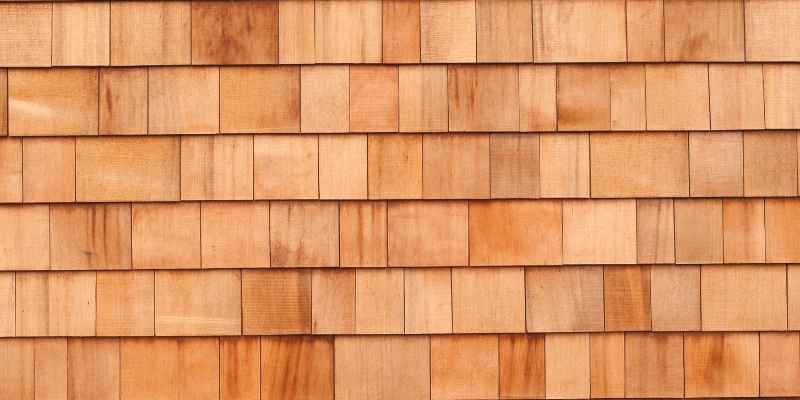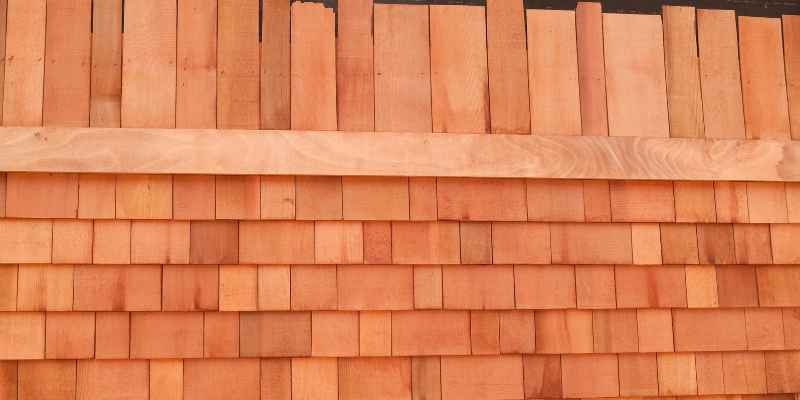The best stain colors for cedar siding depend on personal preference, but a transparent layer of clear is a great choice for keeping the wood’s natural appearance while adding a layer of protection. Cedar siding is ideal for staining because the natural fibers absorb the stain, making it last longer than paint.
Stains come in semi-transparent or solid-color formulas. Cedar siding is a popular choice for many homeowners due to its natural beauty and durability. However, choosing the right stain color can be a daunting task. With an overwhelming number of options available, it can be challenging to make the right decision.
This article will guide you through the process of selecting the best stain color for cedar siding, depending on your personal preference. You will also learn about the benefits of staining cedar siding and the difference between semi-transparent and solid-color stains, which will help you make an informed decision.

Benefits Of Staining Cedar Siding
Cedar siding is popular for homes because of its natural beauty and durability. However, it is essential to maintain the wood against weather elements and insects for it to last and keep its look. Staining cedar siding is an excellent solution to protect the wood from damage while retaining its natural charm. Here are some benefits of staining cedar siding:
Protection From Weather And Insects
One of the most significant advantages of staining cedar siding is the protection it offers against weather and insects. Cedar is naturally resistant to decay and rot, but it is still susceptible to damage from sun, wind, and water. Insects such as termites and carpenter ants can also damage the siding if left untreated. Staining cedar siding provides a seal that repels water and other elements, protecting the wood from damage and increasing its lifespan.
Retains Natural Beauty Of Cedar
Cedar siding has a natural beauty that many homeowners want to preserve. Staining cedar siding helps to maintain the natural color and texture of the wood. There are various stain colors available, and homeowners can choose one that enhances the wood’s natural coloring or adds a different look to the exterior.
Increases Lifespan Of Cedar Siding
Staining cedar siding helps increase its lifespan by protecting it from damage caused by weather and insects. The wood will last longer, and homeowners can avoid costly repairs or even replacement in the future. Staining cedar siding is an essential step in maintaining the home’s exterior and increasing its value.
Choosing the right stain color depends on personal preference, the style of the home, and the surroundings. Here are some popular stain colors for cedar siding:
- Semi-transparent stain – This stain allows the natural wood grain and texture to show through, providing a natural look.
- Semi-solid stain – This stain partially covers the wood, highlighting the natural color while adding more depth and tone.
- Solid stain – This stain completely covers the wood, providing a uniform color and finish. It is ideal for older cedar siding that needs a revitalized look.
When choosing a stain color, consider the exterior surroundings, the home’s architecture, and the desired look. A lighter stain color can make the home look more spacious, while a darker stain color can add warmth and depth. It is essential to choose a good quality stain that will protect the cedar siding and enhance its natural beauty.
Popular Stain Colors For Cedar Siding
Enhance the natural beauty of your cedar siding by choosing the right stain color. A transparent layer of clear stain is an excellent choice for showcasing the wood’s natural appearance, while also providing protection. Consider neutral colors for a traditional look or bolder shades for a Craftsman-like aesthetic.
erent color? Absolutely, cedar siding can be stained a different color if you want to update the look of your home or if you want to change the color to match your taste and preferences. When it comes to staining cedar siding, there are different types of stains and colors that you can choose from. In this article, we’ll focus on the popular stain colors for cedar siding, including clear, transparent colors, semi-transparent colors, and solid colors.
Clear
Clear stain is perfect if you want to preserve the natural beauty of your cedar siding while still protecting it from the elements. Clear stain does not change the color of the wood, but it enhances its natural grain and texture. This type of stain is ideal if your cedar siding is in good condition and you want to maintain its original look.
Transparent Colors
Transparent stains are available in different colors, including natural, redwood, and cedar. They are a great choice if you want to add some color to your cedar siding while still allowing its natural grain to show through. Transparent stains are ideal if you want to highlight the texture and beauty of your cedar siding.
Semi-transparent Colors
Semi-transparent stains are the most popular type of stain for cedar siding. They provide a balance between color and texture, allowing some of the wood grain to show through while still providing a noticeable color change. Semi-transparent colors come in a variety of shades, including natural, redwood, and cedar.
Solid Colors
Solid colors are ideal if you want to completely change the color of your cedar siding. They come in a variety of hues, from light to dark, and cover the wood grain completely. Solid colors are a great choice if your cedar siding has a lot of imperfections or if you want to create a bold color statement.
In conclusion, selecting the right stain color for your cedar siding depends on your personal preferences, the condition of your cedar siding, and the look you want to achieve. Whether you choose clear, transparent, semi-transparent, or solid colors, make sure to use a high-quality stain and follow the manufacturer’s instructions for best results.
Factors To Consider While Choosing Stain Colors
When choosing stain colors for cedar siding, consider the natural color and grain pattern of the wood, the style of your home, and the surrounding environment. A transparent or semi-transparent stain can enhance the natural beauty of cedar while a solid color stain can provide more protection and a different look.
Staining your cedar siding can enhance both the look and the durability of your home. But with so many stain colors available, choosing the right one can be intimidating. Consider these factors to ensure that you choose a color that satisfies your style, environment, and practical concerns.
Existing Color of Cedar Siding
The existing color of your cedar siding is a crucial factor in your stain color choice because it will affect how the color appears, and whether you can choose a darker or lighter one than your current siding. If you want to maintain a natural cedar color, a transparent or semi-transparent stain is the best choice. For darkening your cedar siding, a semi-solid or solid stain would be ideal.
Neighborhood Aesthetics
Consider the surrounding homes in your neighborhood when choosing a stain color for your cedar siding. The color should complement the nearby houses and still express your personal style. If you’re unsure which color will fit, speak to your HOA or consult an expert contractor.
Exposure to Sun and Climate
The sun and climate are vital factors when choosing a stain color. If your home receives a lot of sunshine, choose a lighter shade of stain, as it will reflect heat and protect your home’s exterior. Conversely, if your home is in damp conditions, a darker stain will withstand moisture.
Personal Taste
Your personal taste is a crucial factor when choosing a stain color for your cedar siding. You must select something that positively matches your preferences and lifestyle, giving you a result that truly satisfies you.
When determining a stain color scheme for your cedar siding, ensure you think about the existing color, neighborhood aesthetic, sun and weather exposure, and personal preference to end with a great result.
Best Color Combinations With Cedar Siding
Choosing the right stain color for your cedar siding is essential to enhance the natural beauty of the wood. Consider using a transparent or semi-transparent stain to maintain its beautiful appearance, or opt for a neutral color for shutters and trim to maintain a traditional look, while bolder accent colors can add a modern twist.
ar siding different colors? Yes! Cedar siding can be stained with a variety of different colors to achieve different looks and styles. Choosing the right combination of colors is important when it comes to achieving the desired aesthetic. In this article, we’ll be discussing the best color combinations with cedar siding, with a focus on neutral colors for a traditional look and bold colors for a contemporary look.
Neutral Colors For Traditional Look
If you’re looking for a traditional look for your cedar siding, then neutral colors are the way to go. These colors will enhance the natural beauty of the wood while still giving it a classic, timeless appearance. Some popular neutral colors to consider include:
- Beige
- Gray
- Off-White
- Light Brown
When choosing a neutral color, it’s important to consider the trim and accent colors as well. Choose colors that complement the cedar siding and create a cohesive look throughout the exterior of the home.
Bold Colors For Contemporary Look
If you want to give your cedar siding a contemporary look, then bold colors are the way to go. These colors will make a statement and give your home an eye-catching, modern appearance. Some popular bold colors to consider include:
- Dark Blue
- Black
- Dark Gray
- Dark Brown
When choosing a bold color, it’s important to keep in mind the overall aesthetic of the neighborhood and area. Choose a color that will stand out in a good way, but still blend in well with the surrounding homes.
In conclusion, when it comes to staining cedar siding, the color combination is key. Whether you’re going for a traditional or contemporary look, choosing the right colors will enhance the natural beauty of the wood and give your home the desired aesthetic. Experiment with different combinations to find the perfect color scheme for your home.

Staining Techniques For Cedar Siding
Enhance the natural beauty of your cedar siding with translucent or semi-transparent oil stains. Choosing a clear finish can also maintain its natural appeal while protecting it. Experiment with different shades and hues from neutral to bold accent colors to complement the overall aesthetic of your home.
Preparation of Surface:
Before applying any stain to your cedar siding, you must ensure the surface is clean and dry. This can be achieved by washing the siding with soapy water and rinsing it thoroughly until no soap suds remain. Allow enough time for the surface to dry completely before applying any stain. Additionally, you may want to use a brightener to remove any stains or discolorations on the wood.
Application of Stain:
There are various staining techniques that can be used for cedar siding, depending on personal preferences and the desired look. One popular option is the semi-transparent stain, which allows the natural beauty of the wood grain to show through. Solid stains also provide good coverage and can hide blemishes on the wood. Remember to stir the stain thoroughly to ensure an even color before application. Use a brush, roller or sprayer to apply the stain, depending on your preference. Always apply the stain in the direction of the wood grain to avoid lap marks and ensure an even coating.
Maintenance of Cedar Siding:
Cedar siding requires regular maintenance to ensure it remains in good condition. Depending on the type of stain you use, you may need to reapply every 2-5 years. Keep an eye out for signs of wear or damage such as cracking, peeling or fading. Regular cleaning and maintenance can help extend the life of your cedar siding.
In conclusion, there are several techniques for staining cedar siding. Proper preparation of the surface, application of the stain and regular maintenance are key to ensuring a beautiful and long-lasting finish. By choosing a stain color that complements your home’s style, you can enhance the overall curb appeal and value of your property.
Comparison Between Stain And Paint For Cedar Siding
Cedar siding can be stained or painted, but choosing the right stain color is important to enhance its natural beauty. Transparent or semi-transparent stains are a great choice to showcase the wood’s features while providing protection from the elements.
Cedar siding is known for its natural beauty, durability, and resistance to decay and insects. Choosing the right finish for your cedar siding is important to maintain its look and protect it from the elements. When it comes to finishes, two popular options are stains and paints. Here we will compare the duration, aesthetics, cost, and effort of application of both stain and paint for cedar siding.
Duration of Finish
Stains are known to penetrate cedar siding and last longer than paints. They don’t peel or crack and can last for up to five years before requiring a touch-up. In contrast, paints tend to form a surface layer that can crack and peel, especially in areas that are exposed to the sun. They generally last between three to five years but require frequent touching up to maintain their look.
Aesthetics of Finish
Stains and paints are available in a variety of colors and shades. However, stains offer a more natural finish by enhancing the natural color and grain of cedar. They come in translucent or semi-transparent options allowing for subtle changes in appearance without hiding the natural wood texture. On the other hand, paint tends to hide the natural texture of wood and comes in opaque colors that can give a uniform and vibrant color to your home.
Cost and Effort of Application
Staining cedar siding requires less effort than painting, making it a DIY project. Also, since stains penetrate the wood, it requires only one or two thin-coat applications that can dry quickly. In contrast, painting cedar siding is time-consuming and involves more prep work. It requires scraping, priming and two coats of paint: to seal and cover the siding. Moreover, paint is more expensive compared to stain.
In conclusion, both stain and paint have their benefits and drawbacks. If you are looking for a natural and low-cost finish, stains are a better option. If you prefer a uniform or vibrant color finish, then paints will work well for you. Stains last longer, require lesser effort in terms of application, while paints require more effort, more time, and higher costs but offer uniform or custom colors. Ultimately, the choice depends on your preference, budget, and the look you want for your home.
Frequently Asked Questions For Stain Colors For Cedar Siding
What Color Stain Looks Best On Cedar?
For a natural and beautiful look, a transparent layer of clear stain is best on Cedar wood. This adds protection while still showing off the natural appearance of the Cedar. For a different color, stains come in semi-transparent or solid-color formulas.
It’s better to stain Cedar than paint it because stain lasts longer and looks more natural.
What Colors Go Good With Cedar Siding?
Neutral colors such as white, gray, or beige complement cedar siding quite well while bolder colors like green or brown provide a Craftsman-like or traditional colonial style. However, if the wood is in good condition, a transparent layer of clear is an excellent choice for a natural appearance, adding a layer of protection.
Can You Stain Cedar Siding A Different Color?
Yes, cedar siding can be stained a different color. Staining cedar siding is an ideal choice as it lasts longer than painting. Stains come in both semi-transparent or solid-color formulas, and they penetrate deep into the cedar fibers to waterproof them and protect from external elements.
Transparent stain keeps the natural appearance of the wood, whereas semi-solid and solid-color stain can change the color. It’s better to choose a color that compliments your home’s exterior.
Is It Better To Stain Or Paint Cedar?
It is better to stain cedar because it lasts longer and enhances the natural beauty of the wood. Stain penetrates deep into the wood fibers to waterproof and protect them from weather elements. Paint offers more protection but can only be applied if the cedar is paint-free.
Choose a transparent layer of Clear to maintain the natural appearance or select a semi-transparent or solid-color formula for a different hue.
Conclusion
Choosing the right stain color for your cedar siding is essential for enhancing your home’s curb appeal. With so many options available, it’s important to consider factors such as transparency, durability, and color compatibility with your home’s exterior. From translucent oil stains to solid latex finishes, there is a wide range of finishes to choose from that can help protect your cedar siding from the elements and enhance its natural beauty.
Whether you opt for a neutral transparent tone or a bold accent shade, the right stain color can add character and value to your home while protecting it for years to come.


